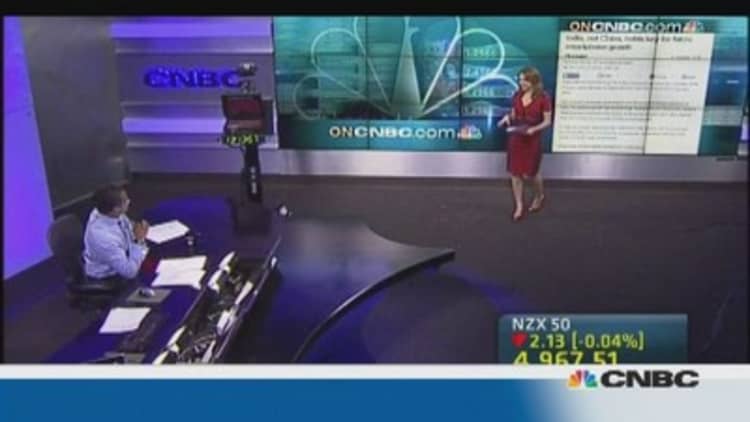India's homegrown mobile phone brands are giving global heavyweights a run for their money as they mop up market share in the country's $13 billion mobile phone market.
Until five years ago there wasn't a single recognizable local brand in India's handset market. However, cut-throat pricing, aggressive marketing and localization changed that; today the top-10 space is dominated by local newcomers including Micromax, Karbonn and Lava, which together account for over 30 percent of the smartphone market. Micromax's 17.5 percent share is second only to Samsung.
"With handsets manufactured in China, these guys started a mobile revolution in India," said Neil Shah, director at technology research firm Counterpoint.
Read MoreIndia stocks are hot-the question is for how long
Local players began gaining traction in 2008-2009 when the smartphone revolution reached China, leading China's feature phone manufacturers to search for new markets. India, which was undergoing a telecom revolution, seemed like a perfect market as policy changes reduced call tariffs and removed import barriers.
India's handset industry, among the world's fastest growing, jumped 20 percent to 226 million units in 2013 according to Counterpoint. It's the second-largest handset market globally after China.
"The time was ripe for regional brands," said Ankur Bisen, senior vice president at consulting firm Technopak, and Indian entrepreneurs gained market share by offering phones at discounts of over 30 percent to the lowest-priced foreign brand.
Read MoreCan India's new finance minister deliver?
"We are not interested in the tip of the pyramid, but the base. 90 percent of phones selling in India are selling at less than 5,000 rupees (around $85), if [major international] brands want to ignore that [segment] it's their problem, we cannot," Shashin Devsare, executive director at Karbonn Mobiles told CNBC.
For Lava, the handset market was an "exciting space" when the company began in 2009.
"We decided to leverage the China ecosystem and took a bottom-up approach. Our research showed that no one was servicing the tier-three and tier-four markets," SN Rai, one of Lava's founders, told CNBC.
Read MoreUnder Modi,can India's economy take on China?
These homegrown brands quickly climbed the value chain and within a few years started selling smart phones, creating a category called "affordable premium". According to Counterpoint's Shah, most Indian smartphones sell for 4,000 to 20,000 rupees ($70 to $340), about $100 less than the iPhone or Galaxy; some even boast similar features.
Indian players were also quick to customize their phones to customers' needs, investing in research and development, design and software design centers to develop new apps.

For instance, the Firstouch phone which hit the market in May allows users to translate English text to an Indian language and vice versa. It also comes with a keyboard designed for Indian alphabets.
"Only 10 percent of the Indian population knows English…so we are targeting those who love their own language and are not comfortable with English," said Firstouch co-founder Rakesh Deshmukh.
Nuisance value
While these Indian players are focused on the low-end market, they still spend big on advertising and marketing. From hiring big-name brand ambassadors to sponsoring big-ticket cricket tournaments, they have created "nuisance value."
Read MoreUS businesses chase India's billion-plus consumers
"We were very bold in our marketing… spending more than 20 percent of revenue initially. We were audacious and [as a result] had people asking 'what is Karbonn?'," said Karbonn's Devsare.
Karbonn is not alone. Last October, Micromax signed Hollywood star Hugh Jackman as its brand ambassador. Meanwhile, Lava has become the official sponsors of English football club Liverpool in India.
Their marketing push also aims to capture foreign markets. Some Indian players have reached Russia and the Middle East and aim to break into Europe and the U.S.
Survival of the fittest
While Indian brands have managed to woo consumers in such a small span of time – with the leader in the pack Micromax clocking sales of over a billion dollars in the fiscal year ended March 2014 – the smaller of the 80-odd players, those with annual revenues of less than $200 million, could fall by the way side in the next three to four years. They need to grow at a feverish pace, even at 100 percent annually, to survive, say experts.
Read MoreAreemerging market equities finally catchingup?
If not, they may have to opt out of the handset market and look to sell smart watches instead, say industry watchers.
But even for the established brands, foreign competition is hotting up, with international players like Lenovo and LG launching phones at very competitive price points, threatening the very unique selling proposition that has made these local players so successful, say experts.
"This [new international launches] could slow down the growth of domestic brands and the growing middle class with disposable income would go after an international brand rather than local brand unless brands like Micromax prove themselves on a global stage and become a global brand, " said Shah.




